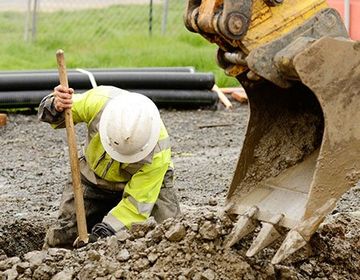Dump Truck Companies in Ohio - Reputable Dump Truck Services Throughout Ohio
Dump Truck Companies in Ohio - Reputable Dump Truck Services Throughout Ohio
Blog Article
Comprehensive Expedition: The Science Behind Superior Excavation Practices
From ancient hand devices to modern hydraulic excavators, the evolution of excavation methods has been a testimony to human ingenuity and technological improvements. What genuinely sets remarkable excavation methods apart is a deep understanding of geological concepts, combined with the application of innovative devices and techniques.
Advancement of Excavation Techniques
Throughout background, the evolution of excavation methods has played a crucial function beforehand construction practices and historical discoveries. From the fundamental devices used by our ancestors to the advanced equipment utilized in modern-day times, the progression of excavation techniques has actually substantially transformed exactly how we come close to different projects.
In ancient times, manual work with standard devices such as shovels, wheelbarrows, and pickaxes was the main approach of excavation. This labor-intensive procedure limited the deepness and scope of excavations, commonly leading to slow-moving development and restricted accessibility to particular sites. Nevertheless, as civilizations advanced, so did the strategies and devices utilized for excavation.
The Industrial Transformation marked a transforming point in excavation techniques with the introduction of steam-powered machinery. In contemporary times, technology plays an essential role in excavation, with improvements like GPS systems, drones, and 3D scanning boosting precision and efficiency in the field.
Role of Innovation in Excavation

The integration of sophisticated modern technology has actually basically changed the field of excavation, improving precision and effectiveness to unprecedented levels - lancaster trenching. One of the vital technological advancements that has considerably affected excavation practices is the application of General practitioner systems.
Moreover, the arrival of 3D modeling and simulation software program has structured the preparation process for excavation tasks. Operators and engineers can now envision the entire excavation procedure before beginning, optimizing and identifying possible difficulties operations. Together with this, the application of drones in excavation tasks has assisted in aerial studies, volumetric measurements, and site evaluations with unmatched speed and precision.
Geological Concepts in Excavation
An understanding of geological principles is important for ensuring the structural stability and security of excavation sites. Geological aspects play an essential duty in establishing the usefulness and safety of excavation tasks (lancaster trenching). One essential geological concept to think about is the sort of dirt or rock existing at the website. Different dirt types, such as clay, sand, or crushed rock, have varying degrees of security and need various excavation techniques. For instance, natural soils like clay may need extra support to avoid collapses, while sandy dirts may be susceptible to erosion throughout excavation.
By performing detailed geological studies and evaluation, engineers and excavators can create techniques to alleviate threats and make certain the effective conclusion of excavation tasks. Inevitably, integrating geological principles right into excavation techniques is crucial for achieving risk-free, effective, and sustainable outcomes.

Most Recent Tools for Excavation
In the realm of excavation methods, contemporary innovations in tools have actually changed the effectiveness and accuracy of excavation processes. These drones can offer thorough airborne surveys of excavation sites, using real-time information on topography and possible dangers.
One more cutting-edge tool gaining appeal is Visit Website the implementation of 3D printing technology for producing personalized excavation devices. This go to this website permits the production of specialized devices that are tailored to the certain demands of a job, increasing performance and minimizing downtime.
Additionally, developments in materials science have brought about the advancement of stronger and extra resilient excavation devices. excavating ohio. Tungsten carbide-tipped excavator accessories, as an example, deal remarkable efficiency in challenging ground conditions, improving efficiency on-site
Scientific research's Influence on Excavation Practices

Additionally, scientific research on soil technicians and geotechnical design has provided useful insights right into soil behavior, allowing excavation experts to make informed choices relating to excavation techniques and soil stablizing methods. On the whole, scientific research continues to drive development and renovation in excavation methods, making excavation jobs much more efficient, economical, and sustainable.

Verdict
In conclusion, the advancement of excavation techniques has actually been substantially influenced by developments in modern technology and a deeper understanding of geological principles. The most up to date tools and equipment used in excavation have improved effectiveness and accuracy in the area. The application of scientific knowledge has useful link actually considerably improved excavation methods, resulting in more effective and sustainable methods for excavating various kinds of products.
In the world of excavation methods, contemporary advancements in devices have changed the performance and precision of excavation processes. By leveraging scientific principles, the excavation sector has been able to significantly enhance efficiency, accuracy, and security in excavation procedures. GPR permits excavation teams to non-invasively check and map subsurface frameworks, energies, and possible risks, enabling them to prepare excavation jobs with greater precision and decreased risk of mishaps.
Furthermore, scientific research study on dirt auto mechanics and geotechnical design has given valuable understandings right into soil habits, enabling excavation experts to make educated decisions relating to excavation approaches and dirt stabilization strategies. In general, scientific research continues to drive innovation and enhancement in excavation techniques, making excavation jobs more effective, cost-effective, and lasting.
Report this page